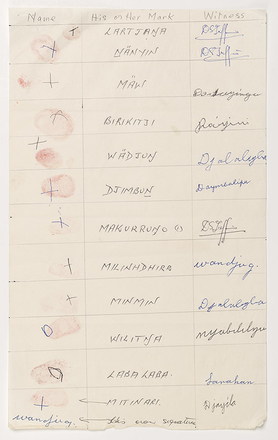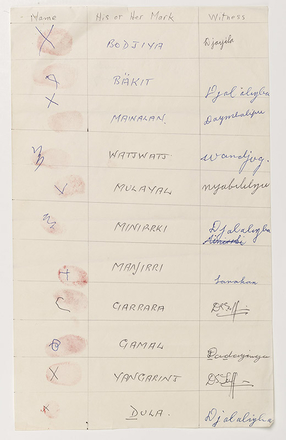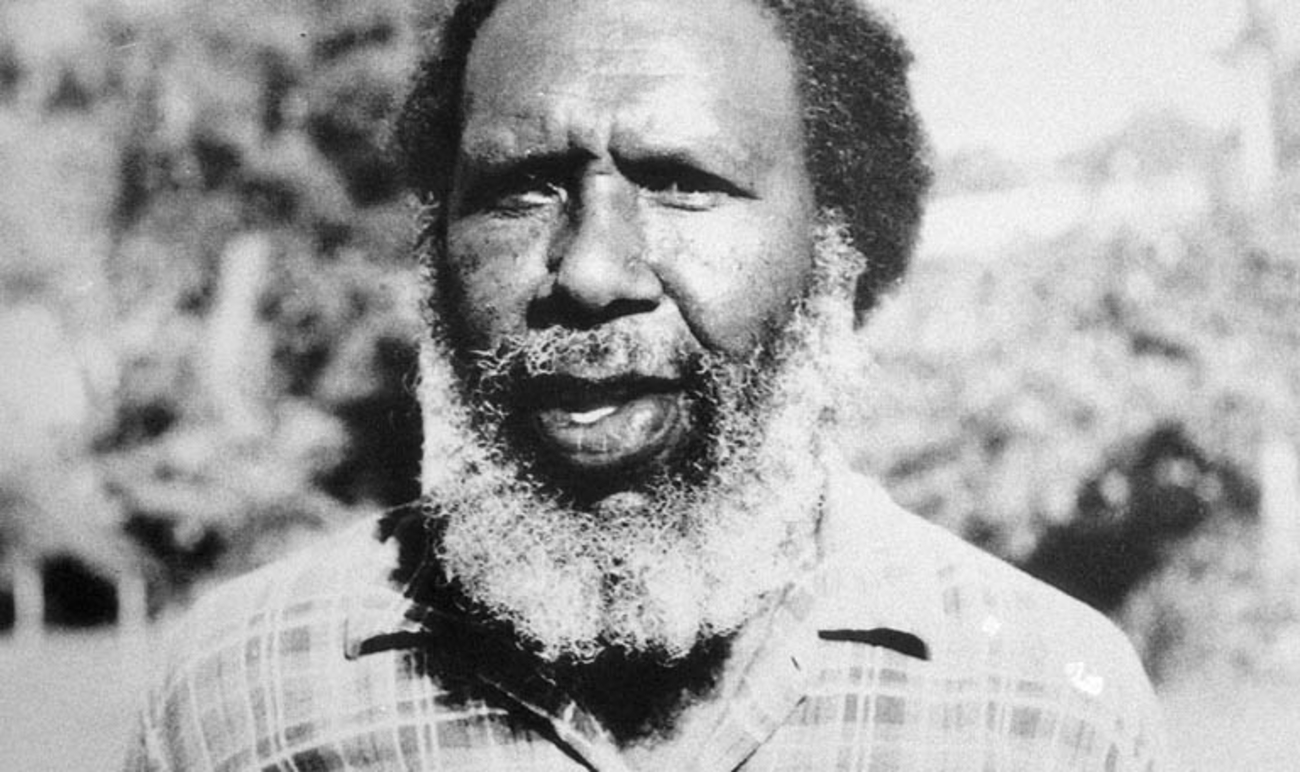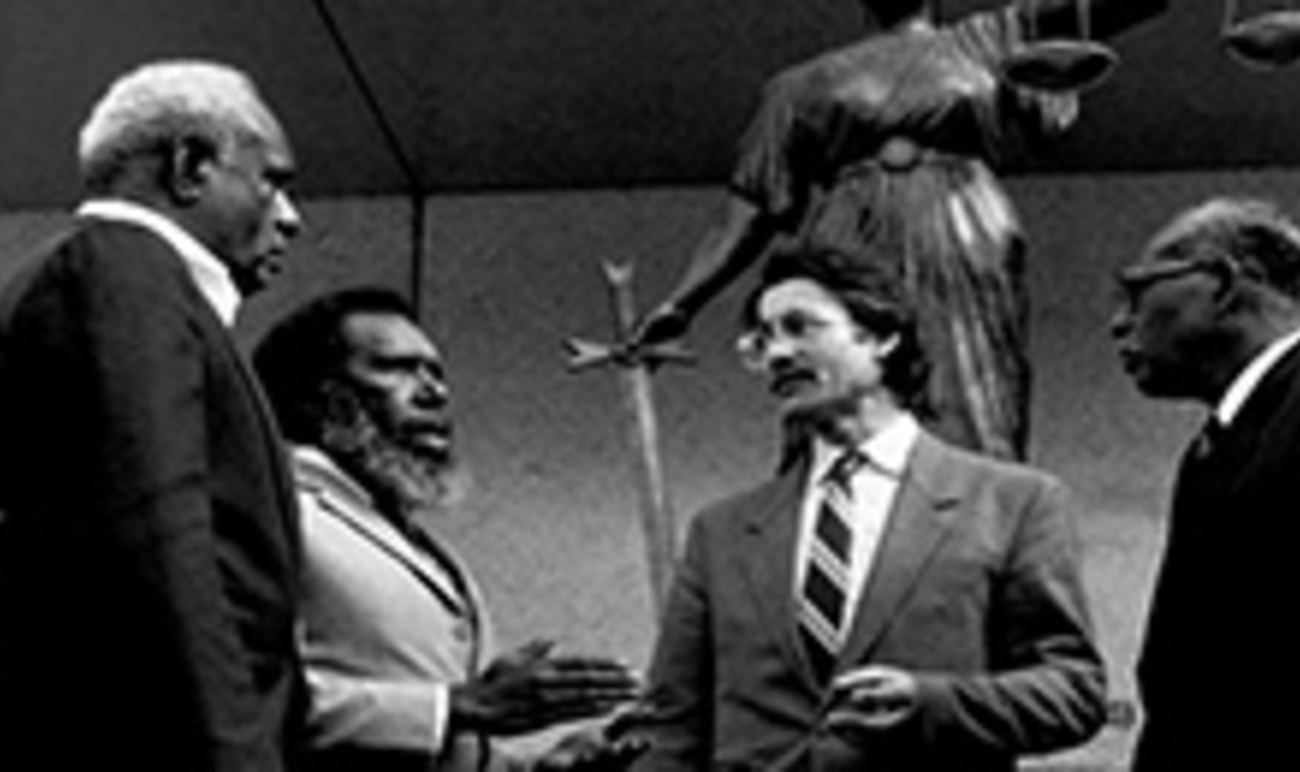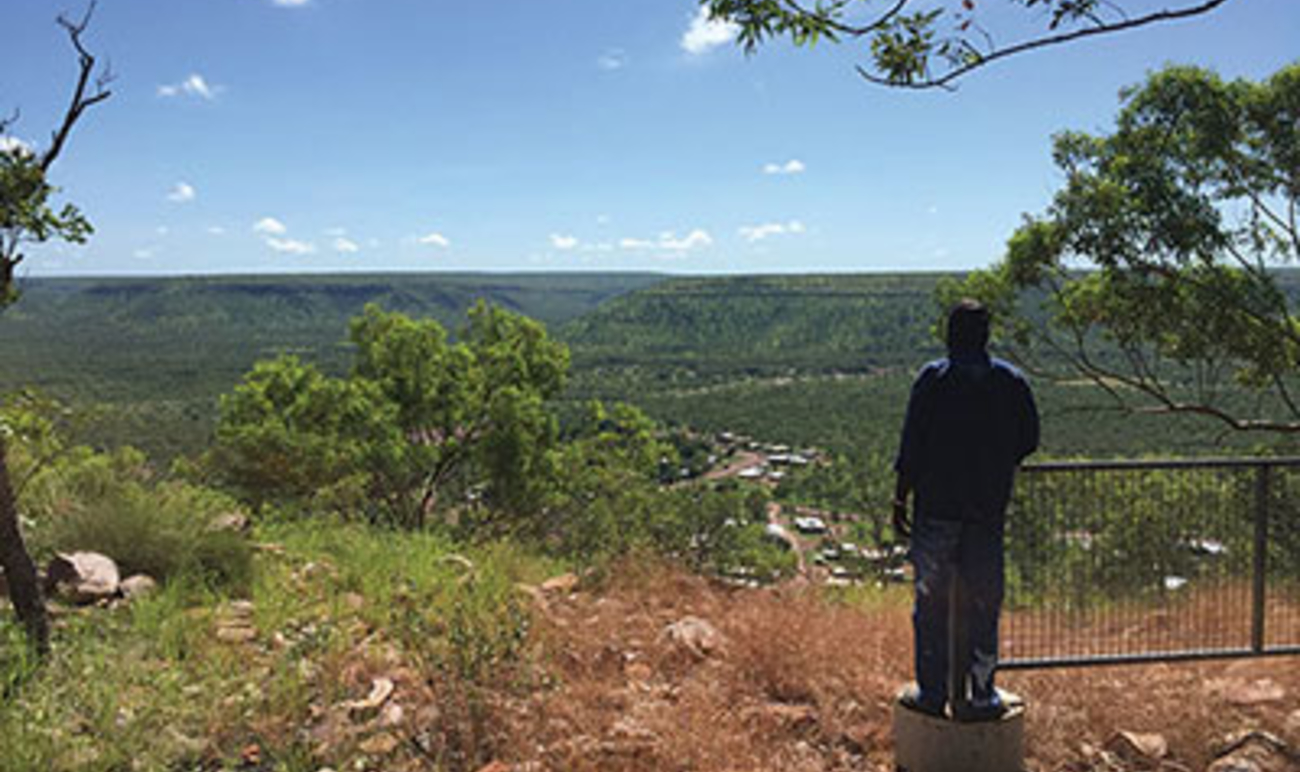'It’s my father’s land, my grandfather’s land, my grandmother’s land. And I’m related to it, which also give me my identity.' – Father Dave Passi
Aboriginal and Torres Strait Islander peoples’ ways of knowing and being in the world are intimately connected to the land and waters. Connection to land is essential to the continued cultural survival of Australia’s First Peoples as well as their economic and social development.
Aboriginal and Torres Strait Islander peoples have occupied the lands and waters of Australia for millennia. Since the beginning of colonisation, Australia’s First peoples have defended their lands and waters and asserted their rights to their homelands.
Yirrkala Bark Petitions

Yirrkala artists, Dhuwa moiety.Yirrkala Bark Petition 14.8.1963 46.9 x 21 cm, natural ochres on bark, ink on paper House of Representatives, Canberra.
Yirrkala artists, Dhuwa moiety.Yirrkala Bark Petition 14.8.1963 46.9 x 21 cm, natural ochres on bark, ink on paper House of Representatives, Canberra.
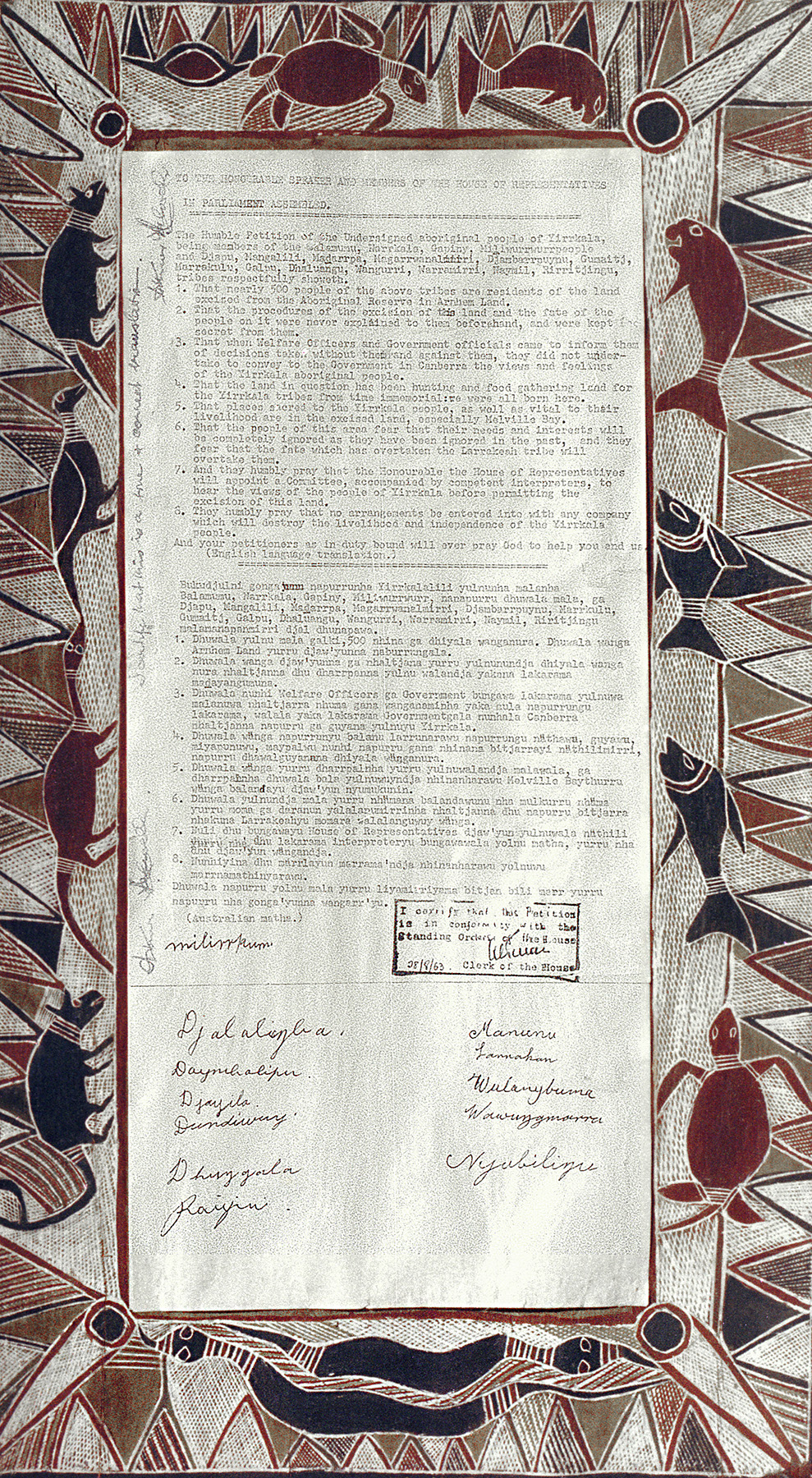
Yirrkala artists, Yirritja moiety, Yirrkala Bark Petition 28.8.1963 46.9 x 21 cm natural ochres on bark, ink on paper, House of Representatives, Canberra.
Yirrkala artists, Yirritja moiety, Yirrkala Bark Petition 28.8.1963 46.9 x 21 cm natural ochres on bark, ink on paper, House of Representatives, Canberra.
The modern land rights movement dates back to 1963 when the Yolngu people from Yirrkala in north-east Arnhem Land (Northern Territory) presented the Australian Parliament with a bark petition. Written in both Yolngu Matha and English, the Yirrkala Bark Petitions protested the removal of land on which Aboriginal people of Yirrkala lived, hunted and maintained connections to sites of significance for thousands of years. Bauxite mining leases were granted by the government and land excised without any consultation with the people of Yirrkala.
'Dhuwala wanga napurrungyu balanu larrunarawu napurrungu nathawa, guyawu, miyspunuwu, maypalwu nunhi napurru gana nhinana bitjarrayi nathilimirri, napurru dhawalguyanana dhiyala wanganura.'
[The land in question has been hunting and food gathering land for the Yirrkala tribes from time immemorial; we were all born here.]
'Dhuwala nunhi Welfare Officers ga Government bungawa lakarama yulnuwa malanuwa nhaltjarra nhuma gana wanganaminha yaka nula napurrungu lakarama wlala yaka lakarama Governmentgala nunhala Canberra nhaltjanna napurruga guyana yulnuyu Yirrkala.'
[When Welfare Officers and Government officials came to inform them of decisions taken without them and against them, they did not undertake to convey to the Government in Canberra the views and feelings of the Yirrkala Aboriginal people.]
Read the full petition transcription of the Yirrkala Bark Petitions
Transcript of the Yirrkala Bark Petitions 1963 (From Wells)
To The Honourable The Speaker and Members of the House of Representatives in Parliament Assembled
The Humble Petition of the Undersigned aboriginal people of Yirrkala, being members of the Balamumu, Narrkala, Gapiny, and Miliwurrwurr people and Djapu, Mangalili, Madarrpa, Magarrwanalinirri, Gumatj, Djambarrpuyny, Marrakulu, Galpu, Dhalnayu, Wangurri, Warramirri, Maymil, Rirritjinu, tribes, respectfully sheweth –
- That nearly 500 people of the above tribes are residents of the land excised from the Aboriginal Reserve in Arnhem Land.
- That the procedures of the excision of this land and the fate of the people on it were never explained to them beforehand, and were kept secret from them.
- That when Welfare Officers and Government officials came to inform them of decisions taken without them and against them, they did not undertake to convey to the Government in Canberra the views and feelings of the Yirrkala aboriginal people.
- That the land in question has been hunting and food gathering land for the Yirrkala tribes from time immemorial; we were all born here.
- That places sacred to the Yirrkala people, as well as vital to their livelihood are in the excised land, especially Melville Bay.
- That the people of this area fear that their needs and interests will be completely ignored as they have been ignored in the past, and they fear that the fate which has overtaken the Larrakeah tribe will overtake them.
- And they humbly pray that the Honourable the House of Representatives will appoint a Committee, accompanied by competent interpreters, to hear the views of the Yirrkala people before permitting the excision of this land.
- They humbly pray that no arrangements be entered into with any company which will destroy the livelihood and independence of the Yirrkala people.
- And your petitioners as in duty bound will ever pray God to help you and us.
Certified as a correct translation. Kim E. Beazley
Bukudjulni gonga’yurru napurrunha Yirrkalalili malanha Balamumu, Narrkala, Gapiny, Miliwurrwurr nanapurru dhuwala mala, ga Djapu, Mangalili, Madarrpa, Magarrwanalinirri, Djambarrpuynu, Gumaitj, Marrakula, Galpu, Dhabunyu, Wangurri, Waramirri, Maymil, Riritjinu malamanapamirri djal dhunapa.
- Dhuwala yulnu mala galki 500 nhina ga dhiyala wananura. Dhuwala wanga Arnhem Land yurru djaw’yunna naburrungala..
- Dhuwala wanga djaw’yunna ga nhaltjana yurru yulnungunydja dhiyala wanga nura nhaltjanna dhu dharrpanna yulnu walandja yakana lakarama madayangumuna.
- Dhuwala nunhi Welfare Officers ga Government bungawa lakarama yulnuwa malanuwa nhaltjarra nhuma gana wanganaminha yaka nula napurrungu lakarama wlala yaka lakarama Governmentgala nunhala Canberra nhaltjanna napurruga guyana yulnuyu Yirrkala.
- Dhuwala wanga napurrungyu balanu larrunarawu napurrungu nathawa, guyawu, miyspunuwu, maypalwu nunhi napurru gana nhinana bitjarrayi nathilimirri, napurru dhawalguyanana dhiyala wanganura.
- Dhuwala wanga yurru dharpalnha yurru yulnuwalandja malawala, ga dharrpalnha dhuwala bala yulnuwuyndja nhinanharawu Melville Bathurru wanga balandayu djaw’yun nyumukunin.
- Dhuwala yulnundja mala yurru nhamana balandawunu nha mulkurru nahma yurru moma ga darangan yalalanumirrinha nhaltjanna dhu napurru bitjarra nhakuna Larrakeahyu momara wlalanguwuy wanga.
- Nuli dhu bungawayu House of Representatives djaw’yn yulnuwala nathili yurru nha dhu lakarama interpreteruy bungawalala yulnu matha, yurru nha dhu djaw’yun dhuwala wangandja.
- Nunhiyina dhu marrlayun marrama’-ndja nhinanharawu yulnuwu marrnamathinyarawu. Dhuwala napuru yulnu mala yurru liyamirriyama bitjan bili marr yurru napurru hha gonga’yunna wangarr’yu.
Australian matha
Signatories
(From bark petition images)
Milirrpum, Djalalingba, Daymbalipu, Dhayila, Dundiwuy, Dhunggala, Raiyin, Manunu, Larrakan,
Wulanybuma, Wawunggmarra, Nyabilingu
In 1971, the Yolngu people again petitioned the government in the Milirrpum v Nabalco Pty Ltd land rights case, commonly known as the Gove land rights case. The Northern Territory Supreme Court acknowledged the Yolngu people’s ongoing relationship with the land and their complex system of laws to govern the land. However, the case ended with the court rejecting the claim because the Yolngu people’s relationship to the land didn’t fit the European concept of ‘property’.
The Yirrkala Bark petitions are one of several significant documents that Aboriginal people have presented to the Australian government. The Northern and Central Land Councils presented the Barunga Statement to former prime minister Bob Hawke at the 1988 Barunga Sport and Cultural Festival. The statement is a powerful declaration of Aboriginal self-determination and rights to land.
Wave Hill walk-off
In August 1966, Gurindji man Vincent Lingiari led his people on a strike for better working and pay conditions at the Wave Hill cattle station in the Northern Territory. The strike soon became more than just about working conditions. Lingiari insisted that the land they were working on was the land of his people and demanded that it be returned.
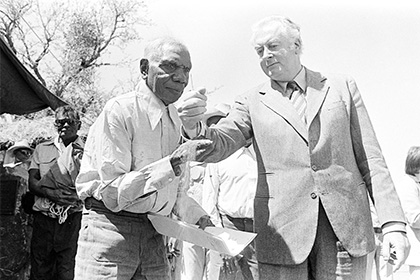
In 1975 Australian Prime Minister Gough Whitlam poured earth into the hands of Vincent Lingiari in a symbolic gesture of returning lands back to the Gurindji people. Courtesy of the National Archives of Australia.
In 1975 Australian Prime Minister Gough Whitlam poured earth into the hands of Vincent Lingiari in a symbolic gesture of returning lands back to the Gurindji people. Courtesy of the National Archives of Australia.
After years of struggle and lobbying, Lingiari was given back his land by Australian Prime Minister Gough Whitlam in 1975. Following the failure of the Gove lands rights case, the Whitlam Labor Government instigated an inquiry into Aboriginal land rights (known as the Woodward Commission), which eventually led to the Fraser Liberal government passing the Aboriginal Land Rights (Northern Territory) Act 1976.
Land rights legislation
The legal recognition of Aboriginal land rights in the Northern Territory provided for the creation of Aboriginal land trusts to hold title to Aboriginal land. The Australian Government started purchasing privately owned land for the benefit of Indigenous communities and allow certain Crown land to be made available for claim. The Aboriginal Land Rights (Northern Territory) Act 1976 has resulted in almost 50 per cent of the Northern Territory being returned to Aboriginal peoples.
Some state governments followed the lead of the Australian Government and introduced their own land rights legislation. But, there were significant limitations placed on the lands that were returned or could be claimed.
Mabo Case
In 1982 a group of Meriam people, Eddie Koiki Mabo, Reverend David Passi, Celuia Mapo Salee, Sam Passi and James Rice, brought an action against the State of Queensland and the Commonwealth of Australia in the High Court. With Eddie Koiki Mabo named as the first plaintiff, the case became known as the Mabo Case.
The Mabo Case challenged the existing Australian legal system from two perspectives:
- On the assumption that Aboriginal and Torres Strait Islander peoples had no concept of land ownership before the arrival of British colonisers in 1788 (terra nullius).
- That sovereignty delivered complete ownership of all land in the new Colony to the Crown, abolishing any existing rights that may have existed previously.
In an historic judgement ten years later, the Court upheld the claim in Mabo and others v. Queensland (No. 2) and ruled that the lands of this continent were not terra nullius or ‘land belonging to no-one’ when European settlement occurred.
The case presented by Koiki Mabo and the people of Mer successfully proved that Meriam custom and laws are fundamental to their traditional system of ownership and underpin their traditional rights and obligations in relation to land. The ruling on this landmark case recognised the fact that Indigenous peoples had lived in Australia for thousands of years and enjoyed rights to their land according to their own laws and customs. The following year the Native Title Act 1993 was passed.
The Native Title Act
The legal uncertainty that followed the Mabo decision prompted a legislative response. By the end of 1993 the Native Title Act 1993 (Cth) was passed. The Act sought to achieve four main objectives:
- To provide for the recognition and protection of native title.
- To establish ways in which future dealings affecting native title may proceed and to set standards for those dealings.
- To establish a mechanism for determining claims to native title.
- To provide for, or permit, the validation of past acts, and intermediate period acts, invalidated because of the existence of native title.
During the same year the Western Australian government sought to pre-empt the Commonwealth by preparing their own legislation to extinguish all native title in the state. Native title was to be replaced by ‘traditional land use’ statutory access rights. Both the WA and Commonwealth Acts were challenged in the High Court. The 1995 Native Title Act case confirmed the Commonwealth legislation was a valid exercise of power and the state legislation was inconsistent and therefore invalid.
Since the introduction of the Native Title Act, native title has been recognised over more than thirty two per cent of the Australian continent.
If you are involved in the native title process and would like assistance to access our Collection please contact our Native title research and access service.
